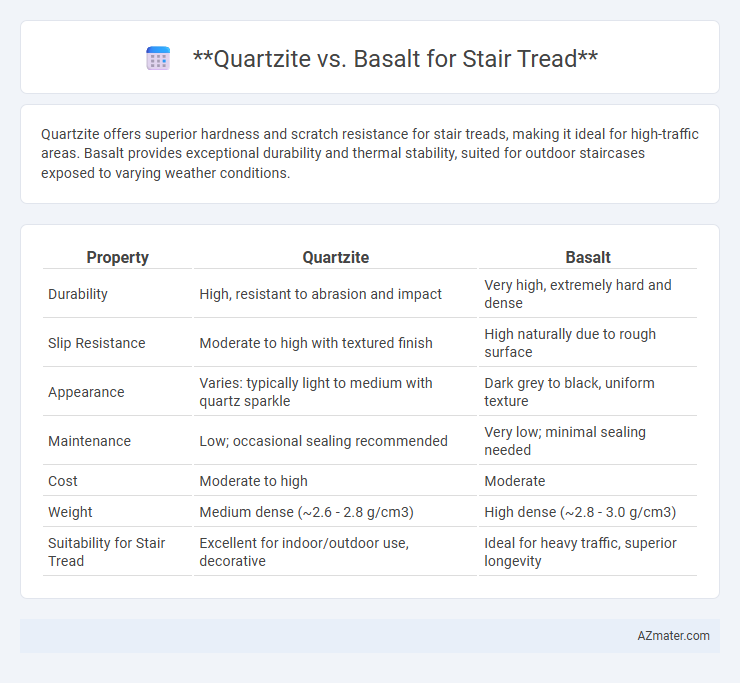Quartzite offers superior hardness and scratch resistance for stair treads, making it ideal for high-traffic areas. Basalt provides exceptional durability and thermal stability, suited for outdoor staircases exposed to varying weather conditions.
Table of Comparison
| Property | Quartzite | Basalt |
|---|---|---|
| Durability | High, resistant to abrasion and impact | Very high, extremely hard and dense |
| Slip Resistance | Moderate to high with textured finish | High naturally due to rough surface |
| Appearance | Varies: typically light to medium with quartz sparkle | Dark grey to black, uniform texture |
| Maintenance | Low; occasional sealing recommended | Very low; minimal sealing needed |
| Cost | Moderate to high | Moderate |
| Weight | Medium dense (~2.6 - 2.8 g/cm3) | High dense (~2.8 - 3.0 g/cm3) |
| Suitability for Stair Tread | Excellent for indoor/outdoor use, decorative | Ideal for heavy traffic, superior longevity |
Introduction to Quartzite and Basalt as Stair Tread Materials
Quartzite is a natural metamorphic rock known for its exceptional hardness and resistance to abrasion, making it a durable choice for stair treads in both residential and commercial applications. Basalt, an igneous volcanic rock, offers high density and excellent compressive strength, providing a robust and slip-resistant surface ideal for stair treads exposed to heavy foot traffic. Both materials are valued for their unique textures and colors, contributing to aesthetic appeal while ensuring structural integrity in stairway design.
Physical Properties Comparison: Quartzite vs Basalt
Quartzite exhibits superior hardness and abrasion resistance with a Mohs rating of 7, making it highly durable for stair treads in high-traffic areas. Basalt, with a Mohs hardness of 6, offers excellent compressive strength and thermal stability, ideal for outdoor stair applications exposed to varying temperatures. Both materials provide low porosity and high density, ensuring longevity and minimal maintenance in stair tread installations.
Durability and Longevity
Quartzite offers exceptional durability and resistance to scratches and wear, making it ideal for high-traffic stair treads with a lifespan of several decades. Basalt is highly dense and tough, providing strong resistance to chipping and weathering, ensuring long-lasting performance in both indoor and outdoor stair applications. Both natural stones surpass many alternatives in longevity, but quartzite's hardness and maintenance ease often translate to superior endurance on stair treads.
Slip Resistance and Safety Features
Quartzite offers high slip resistance due to its natural rough texture and hardness, making it a safer option for stair treads in wet or high-traffic areas. Basalt is also durable and dense but typically has a smoother finish that can be more slippery when wet unless treated with a textured or anti-slip surface. Choosing quartzite stair treads enhances safety by reducing slip hazards, while basalt requires additional surface treatments to meet similar slip resistance standards.
Aesthetic Appeal and Design Versatility
Quartzite stair treads offer a stunning natural sheen with intricate veining patterns that enhance aesthetic appeal, making them ideal for upscale and contemporary designs. Basalt provides a sleek, uniform matte finish with rich dark tones, delivering a minimalist and modern look suitable for industrial or urban interiors. Both materials exhibit exceptional design versatility, allowing customization in texture and finish to complement various architectural styles.
Maintenance Requirements and Costs
Quartzite stair treads require minimal maintenance due to their natural hardness and resistance to scratching and staining, typically needing only regular cleaning with mild soap and water. Basalt, while also durable and dense, demands more frequent sealing to prevent moisture absorption and potential surface damage, resulting in higher upkeep costs over time. Initial costs for quartzite tend to be higher, but lower maintenance expenses make it more cost-effective compared to basalt in long-term stair tread applications.
Climate and Weather Resistance
Quartzite offers exceptional climate and weather resistance for stair treads, featuring a high-density structure that resists moisture, freeze-thaw cycles, and UV exposure, making it ideal for both hot and cold climates. Basalt is also durable and weather-resistant, with strong compression strength and low porosity, but it can be more prone to surface weathering and color fading under intense sunlight over time. For outdoor applications exposed to harsh weather, quartzite generally outperforms basalt due to its superior hardness and minimal maintenance requirements.
Installation Complexity and Cost
Quartzite stair treads require skilled installation due to their hardness and brittleness, often increasing labor costs compared to basalt. Basalt, being denser and less brittle, allows for easier cutting and shaping, reducing installation time and expenses. Cost-wise, quartzite materials tend to be pricier than basalt, making basalt a more budget-friendly choice for stair treads with simpler installation.
Environmental Impact and Sustainability
Quartzite stair treads, composed mainly of natural metamorphic rock, offer high durability with minimal processing, reducing carbon emissions compared to more energy-intensive materials. Basalt, formed from volcanic lava, is also environmentally favorable due to its abundant availability and resistance to weathering, which extends lifespan and lowers replacement frequency. Both stones have low maintenance needs, but quartzite's slightly higher hardness contributes to longer-lasting stair treads, enhancing sustainability through reduced material consumption.
Best Applications and Final Recommendations
Quartzite offers exceptional durability and resistance to scratching, making it ideal for stair treads in high-traffic residential or commercial areas where aesthetic appeal and hardness are priorities. Basalt provides excellent slip resistance and weather tolerance, which suits outdoor staircases or spaces exposed to moisture and temperature fluctuations. For indoor stair treads requiring a refined look with long-lasting wear, quartzite is recommended, while basalt is best for functional, slip-resistant outdoor applications.

Infographic: Quartzite vs Basalt for Stair Tread
 azmater.com
azmater.com